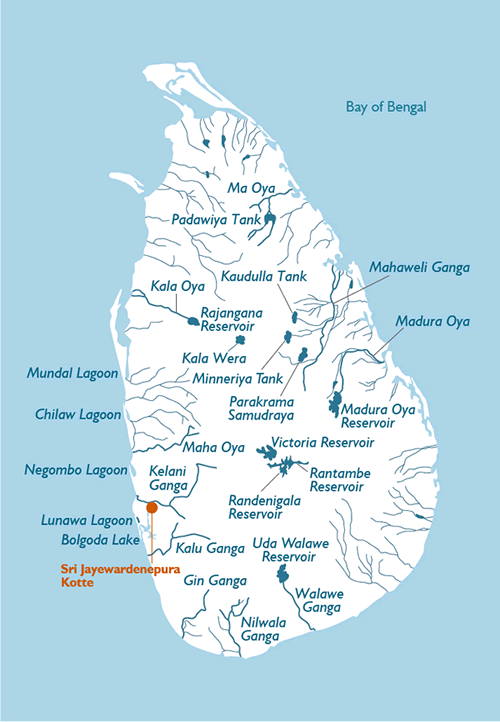State of water environmental issues
Overview
There are three different climatic zones in the country: wet, intermediate, and dry. Annual rainfall for each climate zone is over 2,000 mm/year for wet zones, between 1,500-2,000 mm for intermediate zones and 1,500 mm/year for dry zones (IGES 2007). These different climatic zones constitute a unique natural feature of the country.
There are 103 natural river basins in Sri Lanka, with a total length of about 4,500km (UNESCO and MoAIMD 2006). The largest river is the Mahaweli River with the size 335km long and 10,448 km2 (MENR and UNEP 2009). In addition, there are a significant number of reservoirs including ancient irrigation reservoirs and recently constructed multi-purpose reservoirs with a total area of 169,941 hectares as following table shows.
Estimated reservoir areas in Sri Lanka
| Type of Reservoir |
Number |
Area (ha) |
Percentage (%)
|
| Major irrigation reservoirs (ancient) |
73 |
70850 |
41.7 |
| Medium scale reservoirs (ancient) | 160 | 17001 | 10 |
| Minor scale reservoirs (ancient) | >10,000 | 39271 | 23.1 |
| Flood plain lakes | Not available | 4049 | 2.4 |
| Upland hydroelectric reservoirs (recent) |
7 |
8097 |
4.8 |
| Mahaweli multipurpose system of reservoirs |
| 13,650 | 8.0 |
| Other | | 17,023 | 10 |
| Total area | | 169,941 |
100 |
| (Source: MENR and UNEP 2009) |
Groundwater resources in the country are estimated at about 7,800 million m3 per year (IGES 2007; MENR and UNEP 2009; Nandalal 2010). Groundwater is the major source of water especially in rural areas, and it is estimated that about 72% of the rural population relies on groundwater for domestic use (Nandalal 2010).

State of Water Quality
It is difficult to comprehend the trend of water quality in public water bodies due to lack of monitoring data. However, the Sri Lanka National Water Development Report (2006) pointed out a variety of quality concerns in Sri Lanka, including contamination by nitrate and bacteria in underground and surface waters mainly due to poor sanitation and untreated wastewater or insufficient wastewater treatment, toxic chemicals from industrial and agricultural activities, and eutrophication in lakes/reservoirs (UNESCO and MoAIMD 2006).
Rivers
Deterioration of water quality has been reported in some rivers. The main cause of water pollution in urban area is dumping of domestic and industrial wastes and untreated wastewater in to water ways. In agricultural areas, agrochemicals are the main pollutants (UNESCO and MoAIMD 2006). Water quality in the Kelani River, which is one of the major water sources for Colombo, is considered to be threatened by untreated or insufficiently treated wastewater (Ratnayake 2010) and solid waste.
Lakes and reservoirs
In general, water quality in lakes and reservoirs is considered good, with the exception of specific areas
where industrial activities are taking place. Expansion of sand-mining activities also affects the river water quality such as increasing turbidity decreasing water flow, and accelerating salt water intrusion. Salt water intrusion accelerated by sand-mining activities in the Kelani River affected drinking water supply (MENR and UNEP 2009) and court cases over sand-mining increased from 709 in 2002 to 2,496 in 2005 (MENR and UNEP 2009).
According to the recent inland water quality monitoring results in selected rivers conducted by the Central Environment Authority (CEA), the water quality of these rivers is considered moderate to good, although not all parameters met the interim ambient water quality standards.
Coastal water
Studies on coastal water quality in Sri Lanka are few in number, although water pollution in coastal water bodies has grown over the past few decades due to rapid development activities and human settlements both in and outside coastal areas. The Coastal Resource Management Project (CRMP) implemented by the Ministry of Fisheries and Ocean Resources reported that the organic pollution in sea water of the Beruwala and Unawatuna areas attributed to high BOD values throughout the year (MENR and UNEP 2009).
Groundwater
A common groundwater quality problem in the country is pathogenic pollution mainly caused by poor sanitation systems such as pit latrines (MENR and UNEP 2009; Nandalal 2010). Nitrate is also identified in coastal aquifers such as in Jaffna (north coast) and Kalptiya (western coast) because of excessive fertilizer use and untreated wastewater (Nandalal 2010). High salinity is also an issue especially in coastal zones, which is exacerbated by excessive groundwater use. Fluoride and arsenic, which is naturally occuring, was identified in some areas of the country (Nandalal 2010).
Reference:
MENR (Ministry of Environment and Natural Resources). 2008. Caring For Environment 2008-2012. Colombo. http://www.environmentmin.gov.lk/temporary_files/Caring%20for%20the%20Environment%20(Action%20Plan%202008-2012.pdf. Accessed 10December 2011.
MENR and UNEP (MENR and United Nations Environment Programme). 2009. Sri Lanka Environment Outlook 2009. Battaramulla.
Nandalal, K.D.W. 2010. "Groundwater Resources." In Proceedings of the National Forum on Water Research Identification of Gaps and Priorities. 16-17 September, Colombo, Sri Lanka.
Ratnayake, R.M.S.K. 2010. "Urbanization and Water Quality Control for the Source of Water in Colombo City, Sri Lanka." Paper submitted to the 1st WEPA International Workshop, Hanoi, Viet Nam, 8-9 March.
UNESCO (United Nations Educational, Scientific and Cultural Organization) and MoAIMD (UNESCO and Ministry of Agriculture, Irrigation and Mahaweli Development). 2006. Sri Lanka Water Development Report. http://unesdoc.unesco.org/images/0014/001476/147683E.pdf. Accessed 10 January 2012.
|

